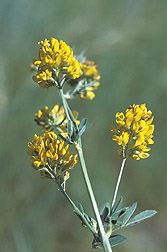This page has been archived and is being provided for reference purposes only. The page is no longer being updated, and therefore, links on the page may be invalid.
|
Read the magazine story to find out more. |
Flowering Alfalfa Yields High-Protein Feed on Northern PlainsBy Rosalie Marion BlissOctober 7, 2003 A species of alfalfa called falcata has been found to thrive on the Northern Plains, where other U.S.-grown varieties fizzle out. The seeds of the yellow-flowering subspecies of the Medicago sativa alfalfa originally came from the Siberian plains. Scientists in the Agricultural Research Service's Rangeland Resources Research Unit (RRRU) at Cheyenne, Wyo., had long been interested in interseeding alfalfa with native species on the plains. ARS is the U.S. Department of Agriculture's chief scientific research agency. Falcata has a fibrous root system that allows it to compete with neighboring plant species for limited moisture on rangeland. Other U.S.-grown alfalfas have a long, main root that burrows deep into soil to draw water. But 80 percent of native grasses and forbs have shorter root systems that snatch the available water before it can get down to deeper roots. ARS soil scientist Gerald Schuman, with the RRRU's High Plains Grasslands Research Station, and colleagues have been working with a rancher who owns 1,500 acres of falcata, land that originally received the seeds nearly 100 years ago. On the land with falcata, Schuman and colleagues have found a large increase in forage production--at times nearly double--compared with rangelands not interseeded with falcata. Part of the reason for falcata's success is that alfalfa--a legume--brings with it friendly bacteria, called rhizobia, which thrive in nodules on the plant's roots. Rhizobia turn atmospheric nitrogen into a form that plants can use to promote their own growth. Schuman found that soil where falcata had been interseeded for at least three years had large increases in nitrogen. Also, the team found evidence that falcata could lower levels of atmospheric carbon dioxide. They saw increases in soil carbon of more than five tons per acre on some falcata-interseeded rangeland, when compared with non-interseeded areas. Read more on this research in the October issue of Agricultural Research magazine. |

